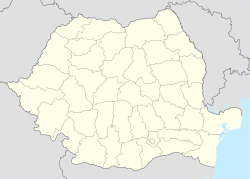Bârlad
| Bârlad | ||
|---|---|---|
| Municipality | ||

Statue of Alexandru Ioan Cuza, downtown Bârlad
|
||
|
||
| Location of Bârlad | ||
| Coordinates: 46°13′N 27°40′E / 46.217°N 27.667°ECoordinates: 46°13′N 27°40′E / 46.217°N 27.667°E | ||
| Country |
|
|
| County | Vaslui County | |
| Status | Municipality | |
| Government | ||
| • Mayor | Constantin Constantinescu (Social Democratic Party) | |
| Area | ||
| • Municipality | 15 km2 (6 sq mi) | |
| • Metro | 20 km2 (8 sq mi) | |
| Population (2011) | ||
| • Municipality | 55,837 | |
| Time zone | EET (UTC+2) | |
| • Summer (DST) | EEST (UTC+3) | |
| Climate | Cfb | |
| Website | www |
|
Bârlad (Romanian pronunciation: [bɨrˈlad]) is a city in Vaslui County, Romania. It lies on the banks of the Bârlad River, which waters the high plains of Moldavia.
At Bârlad the railway from Iași diverges, one branch skirting the river Siret, the other skirting the Prut; both reunite at Galați. Along with a maze of narrow and winding streets, Bârlad features several notable modern buildings, including the hospital administered by the Saint Spiridion Foundation of Iași.
In the vicinity of the city there are traces of a Roman camp.
Scholars continue to debate the origin of the city's name. The Hypatian Codex mentions a market town called Berlad, and some historians, influenced by a document Bogdan Petriceicu Hasdeu published in the 19th century, have tried to link this town and its inhabitants (variously considered Romanians, Russians or an amalgam) with the Moldavian Bârlad. Ioan Bogdan demonstrated that the Hasdeu document was false, thus invalidating the hypothesis. Like Siret and Suceava, the medieval town took its name from the adjacent river, but nothing more can be said for certain. Constantin Cihodaru linked the name, of possible Hungarian origin, to a Slavic word (berlo — "rod", "cottage" or birlo — "swamp"), to which was added the Hungarian suffix -d, also found, for example, in the names Cenad, Arad, Tușnad and Tășnad. Supporting this notion is the historic presence of a significant Hungarian community, with traditions recalling the fight against the Tatars in the mid-14th century.
...
Wikipedia


